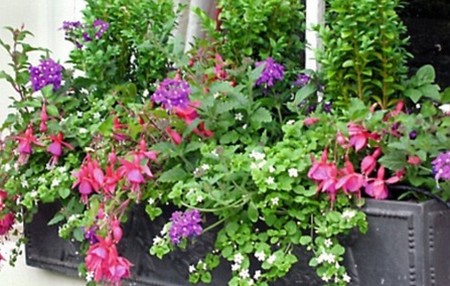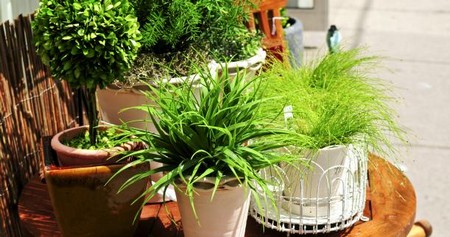Best Way to Choose Containers for Flower Arrangement
The container is the key to the success of the arrangement. It must complement the flowers or foliage in texture, colour and form and enhance the display without dominating it. When you arrange flowers for your house, you sometimes look for a suitable container in which to put flowers you have bought or been given, or, more often if you grow your own flowers, you have a favourite container which stands in a permanent position, and which you aim to keep filled, when you can, with seasonal material.
It is very easy to become complacent and conventional about the containers you use without realizing how the impact of different containers can vary. This article show some of the choices open to you, including both antique and modem containers in a variety of different materials. Try to be adventurous in your choice, and keep your eyes open for chipped or broken bargains – jugs, dishes and bowls – that can be bought inexpensively because of their condition and whose faults and blemishes are often easily masked by their contents.
Aluminium, Tin and Wirework
Metal and wirework containers have the virtue that they are monochromatic, allowing the flower shape and colour to dictate the mood of the display. Solid metal containers can be used either to create a strong statement of form, matched to an architectural display of tulips, for example, or they can be used as the contrast to a much more ethereal arrangement – massed tiny heads of gypsophila, cow parsley or field buttercups for example. Many different kinds of metal can be used – silver, aluminium and plain honest tin. They come in many forms – from buckets and jugs to household tins and pots. The metal can be unadorned, or enamelled or painted. Shiny metal suits strong displays while dull and beaten metal looks well with pale colours and delicate textures. Even household baking tins make good containers, as do recycled tins. These types of container are ideal for displays of fresh flowers in a natural arrangement.
First introduced in the nineteenth century, wire containers are back in vogue again. Particularly good for holding displays of container-grown plants, they can also be used, with the help of moss and a waterproof, invisible inner container, for fresh flowers. They look best containing small pots of violas or ferns, to echo the Victorian charm of their early forebears.
Ceramics and Terracotta
The traditional materials for containers -plain, glazed, decorated or in their natural state – ceramics, earthenware and terracotta make a splendidly diverse range to suit almost every kind of display. The myriad shapes – howls, jugs, cups, mugs, jars and plates – allow you great scope as a flower arranger. They are also the most versatile and work well for dried, fresh or artificial forms of flower material. Earthenware tends to be best suited to simple colours and flower forms and shapes, its tough texture and cleat form an ideal companion for them. Fine china with restrained patterning makes a suitable container for pretty fresh flowers with delicate forms and pastel colours, and for dried flowers as well.
Household cups and mugs can be used for simple arrangements such as a single bunch of dried flowers. They look effective if you arrange a row of them in among your china collection. Larger pots, tureens and vegetable dishes can be used for handsome flower arrangements tor table centres.
Glass
Most forms of glass container are see-through, although there is a growing range of modern ‘smoked’ or opaque glass, some of it in wonderfully rich colours. The advantage of a cleat glass container is that your eye focuses entirely on its contents, rather than on its form. It is therefore an ideal type to use to show off particularly glorious flowers. However, because the stems and water show through you need to be meticulous about clearing the stems of leaves and replacing the water
Categories
Advertisements
Recent Articles
 How to Understand Bed Sizes – A Small Guide
How to Understand Bed Sizes – A Small Guide How to Select Some Must Have Kitchen Accessories
How to Select Some Must Have Kitchen Accessories Best Way to Change a Car Tire
Best Way to Change a Car Tire Best Way to Write an Affirmation
Best Way to Write an Affirmation Best Way to Take Charge of Your Financial Life
Best Way to Take Charge of Your Financial Life Best Way to Survive a Party When You Don’t Know Anyone
Best Way to Survive a Party When You Don’t Know Anyone Best Way to Stop Self Sabotaging Yourself
Best Way to Stop Self Sabotaging Yourself Best Way to Start Journal Writing
Best Way to Start Journal Writing Best Way to Speak with a Powerful Voice
Best Way to Speak with a Powerful Voice Best Way to Simplify Your Life
Best Way to Simplify Your Life Best Way to Respond to a Put-Down
Best Way to Respond to a Put-Down Best Way to Reduce Acne Breakouts
Best Way to Reduce Acne Breakouts Best Way to Recover from Dining Disasters
Best Way to Recover from Dining Disasters Best Way to Quit Your Job Gracefully
Best Way to Quit Your Job Gracefully Best Way to Make Your Own Website
Best Way to Make Your Own Website



Leave a Reply